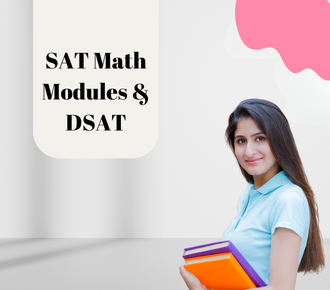- 9:30am - 6:30pm, Mon - Sun
- +91 7836034313
- R2-149 first floor M3M Cosmopolitan, sector 66 Gurugram 122102

Scoring well in SAT Math requires a clear understanding of topics, problem-solving techniques, and effective time management. The SAT Math modules and DSAT (Diagnostic SAT Assessment Test) are designed to assess your math readiness and help identify areas that need focused practice.
This guide offers a structured approach to preparing for SAT Math by explaining key modules, common problem types, and DSAT practice strategies. Along with SAT Math tips, SAT Math notes, and a full SAT Math syllabus, it includes chapter-wise recommendations, practice questions, common mistakes, and a downloadable checklist. Explore expert tutors, free-trial, and pricing plans for personalized learning.
✔ Helps you identify your strengths and weaknesses
✔ Provides a roadmap to structured and efficient practice
✔ Builds problem-solving speed and accuracy
✔ Prepares you to tackle time constraints in the actual exam
✔ Reduces anxiety by focusing on targeted areas
✔ Encourages a data-driven preparation approach using DSAT results
The SAT Math section is divided into two parts—Math Test – Calculator and Math Test – No Calculator. These cover a variety of topics organized into modules.
Linear equations and inequalities
Systems of equations
Quadratic equations
Functions and their properties
Exponents and radicals
Ratios, proportions, and percentages
Probability and statistics
Data interpretation (tables, graphs, charts)
Word problems involving rates and work
Polynomial expressions
Rational expressions and equations
Complex numbers
Function transformations
Exponential and logarithmic relationships
Circles, triangles, and polygons
Coordinate geometry
Angles, areas, and volumes
Right triangles and trigonometric ratios
Diagnostic questions covering all modules
Speed-based drills
Problem-solving under time constraints
Error analysis and targeted practice recommendations
Download the full syllabus and DSAT sample here.
Linear Equations & Functions – Frequently tested with conceptual and applied problems.
Data Interpretation & Statistics – Important for word problems and graphs.
Quadratic Equations – A must-know topic for algebra-based problems.
Coordinate Geometry – Essential for distance, midpoint, and slope-based questions.
Geometry of Circles and Angles – Frequently used in both calculator and no-calculator sections.
Polynomial expressions
Rational equations
Exponential and logarithmic problems
Complex numbers
Trigonometric functions beyond basic ratios
Advanced geometry problems involving proofs
✔ Review each module thoroughly before practicing DSAT problems
✔ Use practice drills to identify weak areas in specific modules
✔ Time your problem-solving sessions to simulate exam conditions
✔ Work on mental math techniques for the calculator-free section
✔ Practice translating word problems into mathematical expressions
✔ Take the diagnostic test without distractions
✔ Review wrong answers and identify conceptual gaps
✔ Focus on modules where you score lowest first
✔ Track improvement week by week
✔ Use DSAT reports to personalize practice sessions
Explore expert-guided practice in our free-trial sessions and pricing plans.
Write formulas for solving linear and quadratic equations
Include examples with step-by-step solutions
Highlight common pitfalls and tricks
Practice graphs and tables with explanations
Summarize probability formulas
Work on interpreting word problems efficiently
Memorize angle properties and circle theorems
Practice drawing diagrams to visualize problems
Solve coordinate problems with formula sheets
Download structured notes templates here.
Skipping DSAT practice—diagnostics help reveal hidden weaknesses.
Ignoring calculator-free drills—mental math is crucial for time management.
Overloading with formulas without understanding their application.
Practicing problems without timing yourself—exam pressure is a different challenge.
Neglecting error logs—tracking mistakes accelerates improvement.
Relying only on practice books without conceptual clarity.
Start by solving a timed diagnostic test to assess your math skills.
Look at module-wise scores to identify weak areas.
Design weekly practice sessions focusing on weak modules.
Use a checklist to monitor improvements and revise areas where errors persist.
Take full-length practice tests to build stamina and speed.
Access sample DSAT tests and reports here.
| Week | Modules | Practice Goals |
|---|---|---|
| 1 | Linear Equations & Functions | Solve 40 problems with speed drills |
| 2 | Data Interpretation | Practice charts and word problems |
| 3 | Quadratic Equations | Review formulas and solve practice tests |
| 4 | Geometry & Trigonometry | Practice angle problems and coordinate questions |
| 5 | Advanced Algebra | Work on polynomials and rational equations |
| 6 | Mixed DSAT Practice | Timed practice covering all modules |
| 7 | Error Review & Revision | Analyze mistakes and revisit concepts |
| 8 | Full-Length Practice Tests | Simulate exam day experience |
✔ Allocate specific time blocks for each module
✔ Use timers during practice sessions
✔ Revise formulas daily for retention
✔ Practice calculator-free problems to improve speed
✔ Track progress weekly and adjust study plans accordingly
Digital formula sheets for quick revision
Interactive graphing tools to visualize problems
DSAT analytics to personalize learning
Practice apps to drill concepts under time pressure
Video tutorials for step-by-step problem-solving
Includes:
✔ Module-wise practice plan
✔ Timed drills and calculator-free exercises
✔ Error log templates
✔ Formula sheets and concept maps
✔ DSAT progress tracker
✔ Common mistakes checklist
✔ Exam simulation planner
Download it here: SAT Math Checklist.
Tutors: Work with specialists to improve weak areas.
Free Trial: Experience module-based learning strategies.
Pricing Plans: Choose a coaching plan that fits your preparation goals.
Mastering SAT Math requires a balance of conceptual understanding, speed, and accuracy. By focusing on modules and using DSAT as a diagnostic tool, you can personalize your learning, improve weak areas, and build confidence for the exam.
Start today by practicing systematically, tracking your progress, and seeking expert guidance. With structured learning and disciplined preparation, high scores in SAT Math are within reach.








